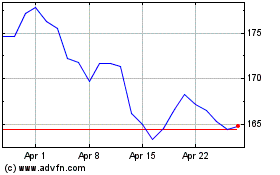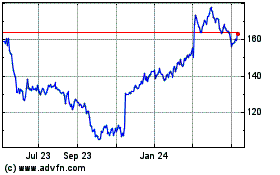Target Hopes Smaller Stores Will Bring In More Millennials -- WSJ
October 05 2016 - 3:03AM
Dow Jones News
By Khadeeja Safdar
Target Corp. is the latest big-box store to try small boxes.
The chain is opening several smaller stores in urban areas and
college towns from New York City to State College, Pa., as it
battles declining traffic and sales at its nearly 1,800-strong
fleet of largely suburban stores.
Near the University of Minnesota campus, Target opened a store
less than 15% the size of an average store. It stocks a limited
assortment of products geared toward college students, like
miniature ironing boards and twin-size sheets. Ping-pong balls are
near the beer. There are no children's toys or strollers.
"We could see hundreds of these," Chief Executive Brian Cornell
said. "It could be a huge part of future growth outlook over
time."
The retail chain recently reported its first decline in existing
store sales in two years and its stock has lost 13% over the past
year. Mr. Cornell is trying to reinvigorate sales and better appeal
to younger shoppers who are increasingly buying essentials online.
Amazon.com Inc., which targets citydwellers for its Prime
membership, has recently increased efforts to attract college
students.
But Target is attempting to succeed where others have struggled,
a sign of the limited options for brick-and-mortar retailers
competing with e-commerce. Wal-Mart Stores Inc. retreated from a
similar experiment earlier this year, closing more than 100 of its
smaller Wal-Mart Express locations to focus on its massive
SuperCenters and grocery-store-style Neighborhood Market
formats.
Unlike Wal-Mart, which opened its Express stores largely in
suburban and rural locations, Target is focusing on densely
populated urban areas and customizing the assortment in each store
to cater to local tastes.
Target executives say the retailer is ready to move away from
its traditional store model to enter new markets. "We had become
really good at stamping out the same store in different markets,"
said Chief Operating Officer John Mulligan. "For these formats, we
are rethinking everything."
The new stores -- typically less than 50,000 square feet
compared with the average Target store of 145,000 square feet --
are in spaces once occupied by grocery stores and neighborhood
retailers. Target also wants customers to use the new stores as
pickup locations for online orders, "as opposed to getting that
ugly sticker from UPS or FedEx that says 'oops I missed you,' "
said Mr. Cornell.
One is slated to open in New York City's Tribeca neighborhood on
Oct. 5 in a space once leased out to a Fairway Market grocery store
that never opened. It will sell a larger selection of baby items to
target the families living in the area. The store will also have a
Chobani Cafe and feature a mural by a local artist.
Mr. Cornell said the new stores are expected to start moving the
needle in the company's overall performance in 2017 and 2018. "It
brings us into neighborhoods where we don't exist today and where
there is demand for our brand," he said.
Some analysts say Target, which has a younger, wealthier
consumer base, may have more success than Wal-Mart, while others
say the strategy has limited growth potential.
"A store in downtown Manhattan is interesting, but is it
scalable?" said Barclays analyst Matthew McClintock. "Wal-Mart
couldn't make it work with a better logistical network. It makes
you wonder how Target is going to succeed."
Target began trying out urban formats in 2012. The company
opened 14 CityTarget and TargetExpress stores over three years and
then later rebranded them as Target. As part of its deal last year
to sell its pharmacies to CVS Health, it also announced plans with
CVS to develop five to 10 small stores over a two-year period.
Mr. Cornell, who became CEO in 2014, has doubled down on
"flexible-format" stores, with plans to increase the total number
to about 60 by next year. The smallest one so far, near University
of California, Berkeley's campus, is less than 10% the size of a
typical Target store.
But downsizing can be challenging. With limited space in
backrooms and on the floor, small stores require more frequent
deliveries to keep items in stock. Big-box retailers also rely on a
certain mix of everyday essentials and high-margin merchandise to
turn a profit and draw customers to the edited selection. Wal-Mart,
for example, carried fewer grocery items in its smallest format and
often placed them in the same region as its Supercenters, giving
shoppers less re ason to visit. Analysts also say Wal-Mart didn't
sell enough high-margin products such as clothing to make the model
as profitable as its larger stores.
"We believe the full-sized Neighborhood Markets are better for
our customers and leverage our entire infrastructure more
efficiently and effectively," said a Wal-Mart spokesman.
To maximize shelf space, Target has been selecting smaller
package sizes and fewer brands for many of the same items offered
in bulk at its larger stores. The company has also been tweaking
the assortment in each store based on sales performance and
customer feedback.
Anne Stanchfield, Target's executive in charge of merchandising
for the new stores, said figuring out the right mix of merchandise
is like a "giant game of Tetris."
Write to Khadeeja Safdar at khadeeja.safdar@wsj.com
(END) Dow Jones Newswires
October 05, 2016 02:48 ET (06:48 GMT)
Copyright (c) 2016 Dow Jones & Company, Inc.
Target (NYSE:TGT)
Historical Stock Chart
From Mar 2024 to Apr 2024

Target (NYSE:TGT)
Historical Stock Chart
From Apr 2023 to Apr 2024
